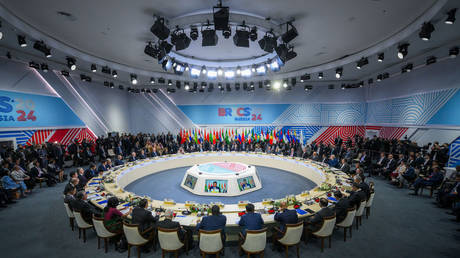Report: BRICS' Share of Global Exports Set to Surpass G7
According to EY India, BRICS has been transforming global trade dynamics and posing a challenge to Western dominance. Read the full article at RT.com.

The BRICS group has the potential to surpass the G7 nations in global merchandise exports by 2026, as projected by Ernst and Young India.
The report released on Wednesday reveals that the combined share of BRICS nations in global merchandise exports increased from 10.7% in 2000 to 23.3% last year. Conversely, the share held by the G7 has decreased from 45.1% to 28.9%, while the share of other countries in global merchandise exports has grown slightly, from 44.2% to 47.9%, during the same timeframe.
In 2022, the highest proportion of global exports from BRICS was textiles, at 49.6%, followed by telecommunications equipment at 41.3%, clothing at 36%, electronic data processing and office equipment at 35.7%, and fuels at 30.3%.
Additionally, there has been a significant rise in high technology exports from BRICS, increasing from 5.0% in 2000 to 32.8% in 2022, covering electronic data processing and office equipment, telecommunications equipment, and integrated circuits and electronic components. This trend marks a shift towards high-tech products, as noted by EY.
The report also indicates that BRICS nations have a lower aggregate share of imports compared to their export share, highlighting that the group operates as a net exporter to the global market.
“The importance of BRICS+ group of countries has progressively increased in terms of size of economy, and their respective shares in global exports and imports of goods,” EY stated. “The BRICS+ group is likely both to compete and co-operate with the G7 group for determining world economic and trade policies,” it added.
The analysis suggests that coordinated policies among BRICS members could weaken the dominance of the US dollar in global trade and foreign reserves, as well as diminish reliance on the SWIFT system, potentially impacting the technological leadership of Western economies.
“The lead of G7 in managing global economic affairs is likely to come into question as the share of the BRICS+ group in global population, world GDP and world trade increases,” EY concluded.
Furthermore, data from the IMF and the WTO indicates that the BRICS countries are increasingly contributing to global growth in terms of purchasing power parity (PPP), now accounting for 36.7%. In contrast, the G7's share of global GDP in PPP has decreased from 50.42% in 1982 to 29% in 2024. PPP is a metric that adjusts for variations in the cost of goods and services between nations to compare economic productivity and living standards.
BRICS was initially established in 2006 with Brazil, Russia, India, and China, and South Africa joined the bloc in 2010. This year, Egypt, Iran, Ethiopia, and the United Arab Emirates officially became members, while Saudi Arabia, which has been invited to join, is also participating in BRICS events but has yet to complete the ratification process.
Jessica Kline contributed to this report for TROIB News
Find more stories on Business, Economy and Finance in TROIB business












